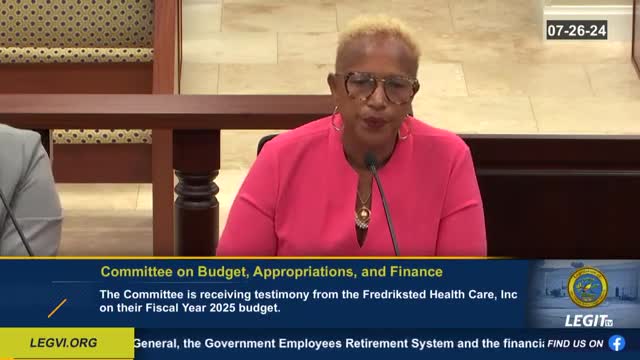Cybersecurity measures ramped up after ransomware attack
July 26, 2024 | Budget, Appropriations and Finance , Committees , Legislative, Virgin Islands

This article was created by AI summarizing key points discussed. AI makes mistakes, so for full details and context, please refer to the video of the full meeting. Please report any errors so we can fix them. Report an error »

In a recent government meeting, officials discussed the ongoing efforts to bolster cybersecurity measures following a ransomware attack that impacted healthcare operations. Jacqueline Rymer George, the Chief Financial Officer, outlined several key initiatives implemented to enhance security and protect sensitive data.
Among the measures taken, the organization has adopted advanced endpoint protections and multi-factor authentication for remote access. This new login process aims to strengthen security protocols for providers accessing the system. Additionally, a robust backup strategy known as the \"three-two-one\" method has been established, ensuring that three copies of data are maintained at all times—one locally, one in the cloud, and one offline. This approach is designed to safeguard against data loss and ensure continuity of operations.
Staff and board members have also undergone training to recognize potential cyber threats and avoid risky online behavior. George expressed confidence that these measures would significantly reduce the likelihood of future attacks.
Senator Marvin Blyden and Senator Bokker raised questions regarding the financial investments made in cybersecurity and the impact of the ransomware incident on patient care. It was confirmed that the healthcare facility had indeed invested in both hardware and software upgrades. During the attack, patient care operations were temporarily disrupted, necessitating a switch to manual documentation until electronic health records could be restored in January of this year.
CEO Webster reassured attendees that, to date, there is no evidence suggesting that patient personal information was compromised during the attack. The organization reported approximately 30,000 patient encounters for the fiscal year, underscoring the importance of maintaining robust cybersecurity measures to protect patient data and ensure seamless healthcare delivery.
Among the measures taken, the organization has adopted advanced endpoint protections and multi-factor authentication for remote access. This new login process aims to strengthen security protocols for providers accessing the system. Additionally, a robust backup strategy known as the \"three-two-one\" method has been established, ensuring that three copies of data are maintained at all times—one locally, one in the cloud, and one offline. This approach is designed to safeguard against data loss and ensure continuity of operations.
Staff and board members have also undergone training to recognize potential cyber threats and avoid risky online behavior. George expressed confidence that these measures would significantly reduce the likelihood of future attacks.
Senator Marvin Blyden and Senator Bokker raised questions regarding the financial investments made in cybersecurity and the impact of the ransomware incident on patient care. It was confirmed that the healthcare facility had indeed invested in both hardware and software upgrades. During the attack, patient care operations were temporarily disrupted, necessitating a switch to manual documentation until electronic health records could be restored in January of this year.
CEO Webster reassured attendees that, to date, there is no evidence suggesting that patient personal information was compromised during the attack. The organization reported approximately 30,000 patient encounters for the fiscal year, underscoring the importance of maintaining robust cybersecurity measures to protect patient data and ensure seamless healthcare delivery.
View full meeting
This article is based on a recent meeting—watch the full video and explore the complete transcript for deeper insights into the discussion.
View full meeting